Lockwood Custom Opticsat the
Winter
Star Party 2017
Warmth, good seeing, and astronomers return to the Keys |
I had a leisurely breakfast on Sunday morning, on a partly cloudy day near the east coast of Florida. Normally I would begin my journey to the Keys fairly early on a Sunday morning, with the goals of reaching Marathon by lunch time and missing a lot of traffic. However, this Sunday was special, because a bit of history was being made. SpaceX was landing a re-usable rocket stage on land for the first time, and being approximately 35 miles from the launch site, I had the big camera lens ready to go to see what I could catch. Just after the launch, I photographed the rocket on its ascent, as seen below at left. The trail was all that remained after clouds obscured the view (right). A few minutes later we heard the rumble of the launch, and I waited for a bit to see if we could see the first stage returning. Due to some scattered clouds, we did not, but we did hear it again about ten minutes later or so, which was quite satisfying and pretty damn cool. I packed up the last of my things and readied myself for the final drive south to the Winter Star Party. As I left my relatives' place on the east coast of Florida, it was a pleasantly warm, mostly sunny day. I set the GPS for the Keys, fired up the iPod for music, turned the car around, and pressed one of my favorite buttons to press in February - the button for the the air conditioning in my car. Unfortunately, nothing happened. All I got was warm air. Oh well. First world problems. So, I got to make the annual journey to the Florida Keys on a warm Sunday with the windows down. Well, I'd call it hot. However, I had my excuse to enjoy the sea breeze blowing through the Keys as I passed through one section of slow traffic between Homestead and Key Largo. I was sitting there with water on both sides of the road and a strong breeze blowing through the car, and I knew that the worst was over. I enjoyed the view, watched a few fishing boats putting along in the shallow water, and finally traffic began to move. This is normal for the Keys, where the road in and out is largely two lanes of distracted tourists with questionable driving skills. After that it was fairly smooth sailing traffic-wise, and I was in Marathon at the rental house well before dinner time. Here's what the GPS looked like from where I parked. 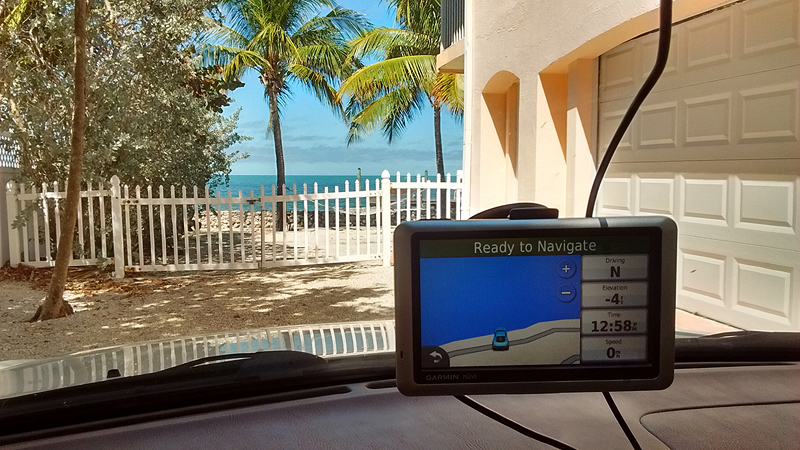 Yes, I could tell it was going to be a very difficult week. Oh well, someone's got to do it, and I had certainly earned the time off. I work best and most efficiently working long hours and getting really in-tune with the optical processes, and that entails working many weekends, especially in the winter when there is little to do outdoors and you don't really want to open the door on some days. Therefore, after lots of overtime, I have no reservations whatsoever about taking a few weeks off so that I can really get in-tune with the vacation process! Sunset was approaching, so I decided to hang out for a bit and catch the sunset and take a photo or two from the dock, thanks to the example set by Dr. Mike Reynolds, another speaker for the event. I had met Mike and his wife Debbie the previous year. The sun sank quickly, and soon was gone. My favorite sunset image is below. Below we see Mike continuing to shoot after sunset, but it was time for me to get something to eat, and that meant a stop by Keys Fisheries on the way to the Winter Star Party site. After an excellent dinner on the water, I headed to the WSP site in the dark and carefully drove in. On Sunday night the event is only open to staff and speakers and their guests. The official event begins Monday at noon. I met up with John Pratte (owner of JPAstrocraft) at the site and we observed for a while with his 32" telescope. The temperature was about 74º F with a breeze out of the northeast, but the weather was warm and humid. John was set up in our usual sheltered area where there was no breeze, and also thankfully no mosquitoes when I arrived. Some badly aimed headlights from cars and trucks on the road would occasionally illuminate the humidity in the air, but they were well screened by trees and brush and were only momentary. The sky was mostly clear, with a few passing clouds showing up early in the evening, and then mostly disappeared. The seeing was quite good, allowing my first view, of the planetary NGC 2440, to be quite nice, especially after I inspected the eyepiece and found it to be a 3.7mm Ethos, giving about 910x with John Pratte's 32" f/3.6 telescope and SIPS! That's how we do observing under good conditions in the Florida Keys. Darren Drake, another speaker this year, and a couple of others were hanging out around the telescope pondering future observing targets. NGC 2440 showed lots of detail at this power, and still focused sharply. Some other targets were NGC 2903, a barred spiral, Abel 21, a faint large planetary, and the area of the Cone Nebula, which was not quite visible due to insufficient transparency. However the Horsehead was seen with direct vision and and H-beta filter. Next up was NGC 2158, a beautiful globular cluster near M35, then IC418, below Orion, which showed a distinctly reddish tint. NGC 3132, the Eight Burst Nebula, was still low, and would be higher later in the night, but it, appeared rectangular to my eye and showed some detail. The Eskimo Nebula, our all-time power champion in previous years at around 2600x, was very nice at 910x. NGC 4565 is a beautiful, large edge-on galaxy with a couple of very distinctive dark lanes, one close to the nucleus and one much larger running through the galaxy. We enjoyed this view very much. Lastly, Jupiter showed nice detail, but a lot of atmospheric refraction due to its low position at the time of observation. We were also observing it over the wheelhouse, the building where talks would be held later in the week, which probably didn't help. Being a bit tired on the first night, we quit around 1am and I drove back to Marathon to get some rest. 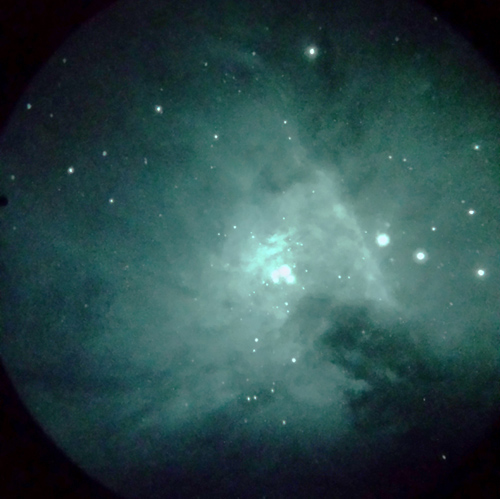 On
Monday I worked on my talk a bit and then went for a run in the local
neighborhood, which was north of the runway at the Marathon
airport. (This is much better than staying in a house under
either end of the runway, where early morning airplane engine roars
will usually wake you up far too early.) After sweating during my
run and checking out the variety of small and large houses and rental
properties in the nearby vicinity, I rinsed off and and did a little
swimming in a rather chilly pool
at the house, which really hit the spot. Dinner was some fresh
sushi that
I bought at the grocery store, and it was quite good. On
Monday I worked on my talk a bit and then went for a run in the local
neighborhood, which was north of the runway at the Marathon
airport. (This is much better than staying in a house under
either end of the runway, where early morning airplane engine roars
will usually wake you up far too early.) After sweating during my
run and checking out the variety of small and large houses and rental
properties in the nearby vicinity, I rinsed off and and did a little
swimming in a rather chilly pool
at the house, which really hit the spot. Dinner was some fresh
sushi that
I bought at the grocery store, and it was quite good.I headed to the camp/site at sunset under mostly clear skies. As is common, clouds passed through periodically, but were more numerous later in the evening. We enjoyed similar views of many objects from the previous night, but we decided to experiment a bit with a new device, a third generation (gen 3) image intensifier. These have variable gain so that the best possible images can be observed for a variety of objects. I want to thank the person who loaned this unit to me so that I could experiment and see how it would best be used for astronomy. I used it to look around quite a bit in the sky with and H-alpha filter and a lens that provided one power. I noted a large area of nebulosity in Vela, which would be the well-known supernova remnant that I have spotted various bright parts of with a telescope and filter during previous WSPs. However, there was also a mysterious vertical spike of nebulosity just east of that in Antlia which I have not yet tried to identify, but which was clearly visible on multiple nights. Al Nagler appeared, or as we call him, uncle Al. He is easy to spot carrying a case full of goodies in the dark, and knows our location well. This year he had a trick up his sleeve. He appeared with a device to adapt an image intensifier (he had one quite similar to the one I was using on loan) to a TeleVue eyepiece, using the same mechanism by which the Dioptrix is attached to the top of an eyepiece. We used the intensifier first in a TeleVue refractor that John Pratte had mounted as a finder on his 32" f/3.6 telescope, and then later in the main scope. At some point Al also pulled out a cell phone adapter that held a phone quite solidly so that good images could be captured easily with the phone. The result, after just a little processing, is seen in the image of M42 a few paragraphs above. It is a very short exposure taken of the output of the image intensifer which was attached to a 17mm TeleVue Delos eyepiece installed in the 32" f/3.6 telescope complete with the Starlight Integrated Paracorr System (SIPS) and its included Feathertouch focuser - this was one was one fun collection of optics and equipment. 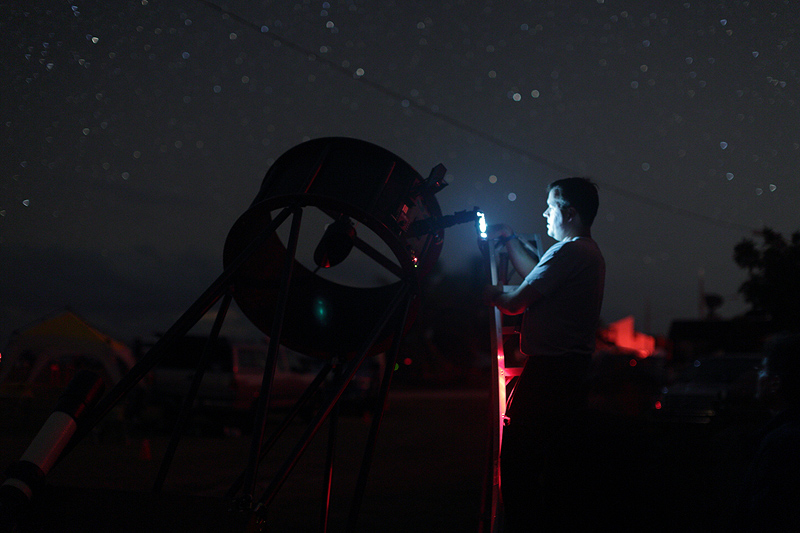 I couldn't help but marvel at the various optics and technology that were being used with my mirrors in John's superb telescope structure. Above is an image of me capturing the M42 image with a friend's cell phone. I know it appears bright, but it was facing away from the rest of the star party and the camera's sensitivity makes the glow appear brighter than it really was. I was able to focus quite critically in real-time and get an image that showed many of the faint stars in the trapezium. Below I captured an image of Al Nagler on the ladder with the glow of the image intensifier on his eye. The small refractor mounted on the big scope is seen at lower left. 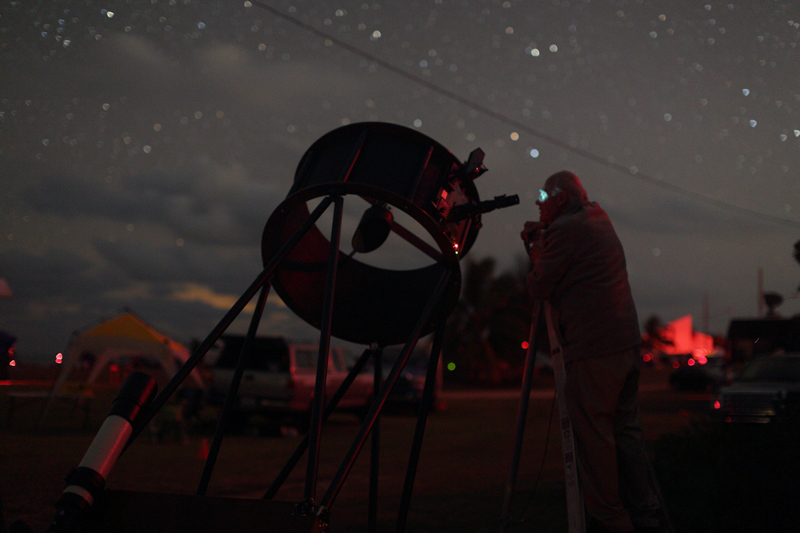 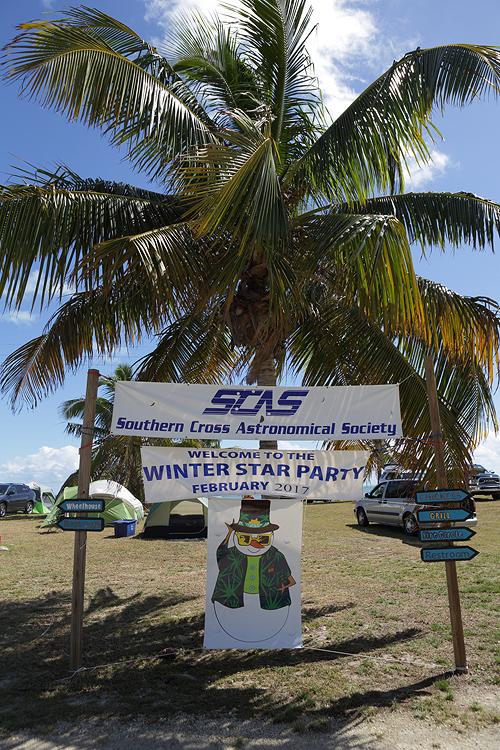 We
had a lot of fun showing M42 to many people with this setup.
Later on in the night we viewed Thor's Helmet. Visually, with
just a normal eyepiece, it was stunning with a UHC in the filter slide,
but it disappeared in the intensifier for an unknown reason. I
later found out that the UHC bandpass was just outside of the spectral
range that the intensifier worked it, so I should not have used the
filter with the intensifier. Thus, it was operator error on my part. We
had a lot of fun showing M42 to many people with this setup.
Later on in the night we viewed Thor's Helmet. Visually, with
just a normal eyepiece, it was stunning with a UHC in the filter slide,
but it disappeared in the intensifier for an unknown reason. I
later found out that the UHC bandpass was just outside of the spectral
range that the intensifier worked it, so I should not have used the
filter with the intensifier. Thus, it was operator error on my part.Overall it was a busy night - we had several people waiting for the telescope most of the night, but some presistent haze and high clouds made observing not quite as good as the previous night. Eventually the clouds thickened and we called it a night. At left we see the Winter Star Party entrance on a beautiful sunny day, but the weather was about to turn in another day or so, and the forecast was well known to attendees. They were getting ready. On Tuesday, Bob and I took a walk over to the Wooden Spoon for breakfast. It's a very basic, affordable diner on the south side of US-1 at the west end of the Marathon airport runway. They have good food, and it's a great way to have a nice late breakfast. After our meal, we walked back to the house and then decided to drive over to the site to register and hang out for a bit there on a cloudy day. Then we went back to Marathon and picked up groceries on the way back to the house. We were pleased to find what turned out to be an excellent strong, dark beer at Publix, just lucky that we noticed it. We returned to the WSP site for for dinner with some of the vendors, and event that is becoming a tradition for me at a couple of star parties. Food was prepared expertly by Paksun, Howie Glatter's wife. It was Korean BBQ as usual, with potatoes, vegetables, etc. Lots of food, excellent beverages, and a good time was had by all. It was dark by the time we finished, and the wind was blowing fairly strongly, a harbinger of things to come. We wandered around the site a bit in the dark, looking for activity and telescopes to use. The 32" was covered and partially disassembled in preparation for rain and wind. The sky was partly clear and various sucker holes appeared and disappeared, but everyone was wisely preparing for the rain that was forecast for Wednesday, and no one wanted to uncover their telescopes. Matthias Wirth, Markus Ludes, and a few others enjoyed a spirited conversation with with Yuri Petrunin of TEC about politics and the 10" refractor he had brough, but unfortunately it was covered, too, and we soon returned to Marathon for drinks on the porch and by the ocean. Wednesday, the day I was to give my talk, came in with a vengeance. The radar image below says it all. The WSP site is just across the gap in the islands (where the Seven Mile Bridge is) to the west of the dot that marks Marathon. This shot was from right before the heavy weather hit. 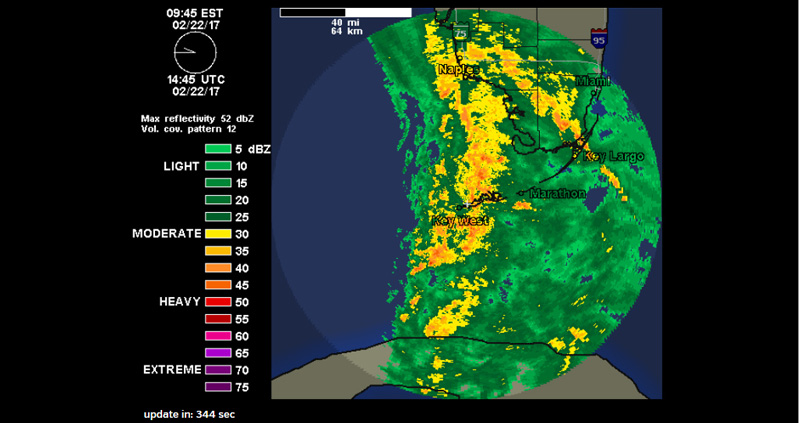 Rain arrived as a front passed through most of the state, and it came with wind. (I heard later that a few telescopes were blown over on the berm.) In the morning I sat in the house doing the last updating of my talk, and watching the rain and wind outside. With that wrapped up, it was time for some lunch and then to get everything packed up for my talk. I left Marathon around noon, and encountered strong winds and rain that made driving over the Seven Mile Bridge a bit interesting and slow, but I'm used to that from living in the wind-swept prairies of Illinois. Clearly some other drivers were not. There was enough rain to flood the very low-lying parts of the observing field at the east end of the site for the third year in a row, I believe, but few people were set up there, or knew that could be expected if it rained heavily. Because of this possibility, John Pratte always raises his telescopes up on bricks to keep them dry, and can wheel them out of harm's way to higher ground if required. The rain had just stopped when I arrived, and I got my computer set up. My talk went well despite some wind and more rain heard outside. I discussed different effects that temperature changes have on telescope structures and the optics themselves, and showed the effectiveness of various fan arrangements through videos of a Foucault/Schlierin test, which reveals moving air of differing temperatures. (Expect an article about this at some point in the future.) I stayed for part of the following talk, but I needed to get out of the dark presentation room for a bit. I emerged into some now partly sunny and still very windy conditions, and talked to friends for a bit before heading back to hear Dr. Mike Reynolds' talk about photographing the total solar eclipse that would happen in mid-2017. This eclipse (and the one in 2024) passes only a few hours drive south of where I live, and we certainly intend to see it. 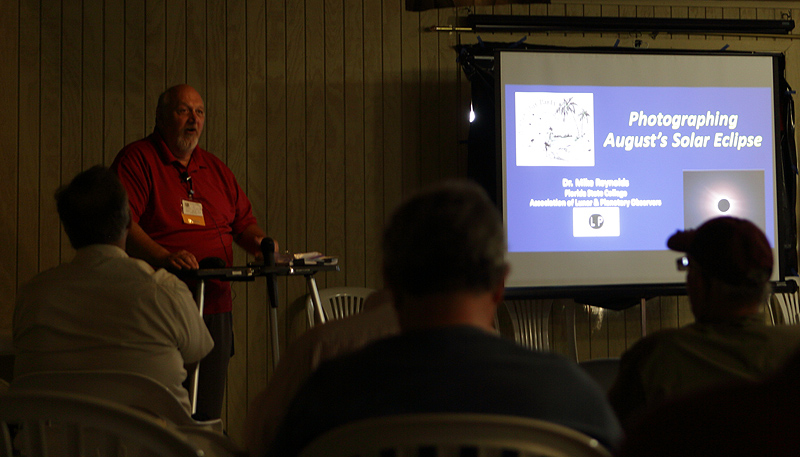 After this I went back to Marathon for a short run, a swim, and a cookout with the Reynolds, Ron Brecher, Dietmar Hager, and various friends and acquaintances, to celebrate our talks being done and to enjoy the house a bit. As it turned out, we picked the right evening to stay at the house. More rain arrived as it got dark and we sat on the screened in porch and watched the wind blow through the palm trees. For someone like me who lives astronomy most of every day and most of the week, I need breaks like these from time to time to enjoy a little mental down time away from questions about optics and thinking about what I have to do when I get home. I stay on-site when I am at Okie-Tex, but try to unplug a bit during the day, go for a run, and enjoy some interesting beverages with friends. Here at WSP, in the beautiful Florida Keys, that relaxation is facilitated by the normally blue sky and water, and the wind through the palm trees. If it's cloudy, I don't get annoyed, I enjoy other activities like on this night. At around 11pm, after doing a little beer tasting with Ron, who at one point took a break to do a little online work, I stepped outside to see a clearing sky, but the stars were uncharacteristically twinkling for the Keys, a sign that the front was passing through and the seeing was not that great at the moment. I believe it cleared again late that night, but I was fast asleep storing up energy for what I hoped would be a good night of observing on Thursday night. 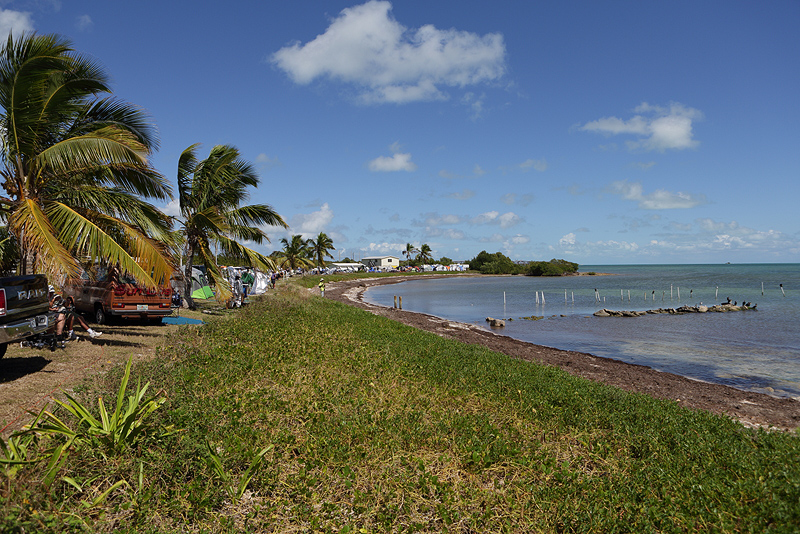 Here's what the site looks like on a sunny day later in the week, looking east from the western part of Scout Key, the small island on which two camps take up the majority of the real estate. The building in the middle is the wheelhouse, where talks are given. 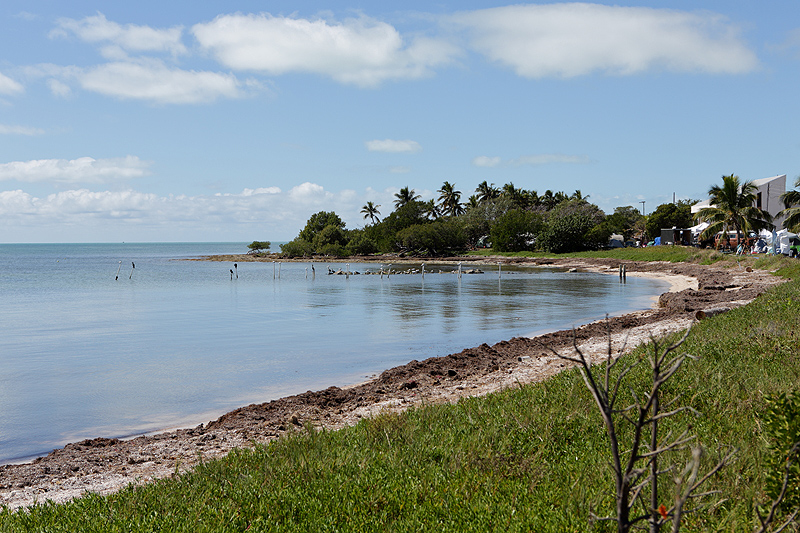 Above is the view looking southwest, back toward the spot from which the previous image was taken. Your telescope can be set up this close to the water if you make the journey to the Winter Star Party. In the dead of winter, imagine yourself standing here, sea breeze and humidity in the air, and your hair (if you still have it) rustling in the breeze. Then log on to the Southern Cross Astronomical Society web site, register for WSP, and start planning your trip. Remember, WSP is at 24 degrees north latitude, so residents of the northern United States get to see TWENTY DEGREES more southern sky than they do at home - if it's actually clear and warm enough to be outside observing at home. The next time you see frost on your telescope in the middle of winter, think of all of us soaking up the sun at the tip of Florida and come join us! 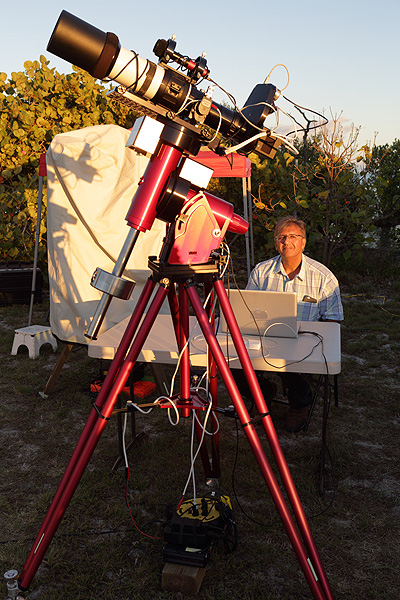 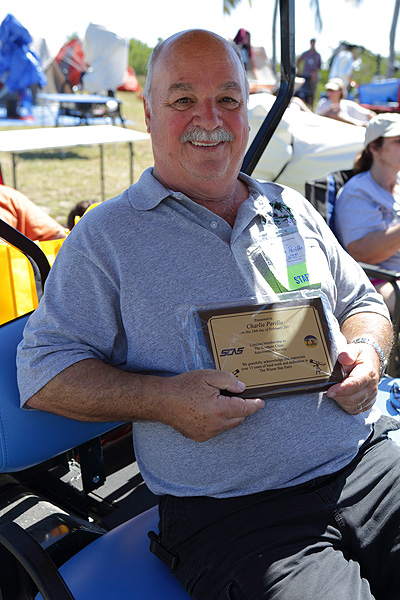 In other activity, let's pay attention to a couple of the organizers. Above left WSP Director Tim Khan waits for dark behind one of his imaging setups. Above right, WSP Host Coordinator Charlie Perillo received a lifetime membership and plaque for his dedicated service to the star party over many years. He can usually be seen in a golf cart running around the site taking care of all of the little (and big) details that need attending to. As always, thanks for letting me play through, Charlie! Also, thanks to all of the WSP staff and volunteers that make the star party run every year. My business has been helped greatly by people seeing what quality telescopes can do under steady Florida skies, and I am very grateful to the WSP and SCAS for putting on this superb event every year, and for asking me to speak frequently there. Thank you! Thursday dawned cloudy, then sunny, at least when I woke up. Pesky clouds appeared later. I can't find my notes for this night, but I believe Dietmar Hager was around for some observing. We were optimistic about improved conditions on Friday night, which was to be my last night. Due to the interruptions by the weather, this was the first time in a while that I didn't get into a "star party rhythm" of staying up fairly late. Clouds seemed to increase on the first few nights as the night went on, then rain arrived for a day or so, and this caused me to go to sleep earlier than usual. On this trip I never stayed up late enough to view the far-south objects in the early morning sky. I was at the site before 11am on Friday for the prize drawing, but luck was not on my side this year. After visiting for a while I went back to Marathon to relax a bit more and for one last seafood meal at Keys Fisheries, and a leisureley last night of observing. I decided to do quite a bit of photography this night because the weather an early bedtimes had left me with relatively few images. Before it got dark I caught up with Kirk and Sheldon, below, with Kirk's 25" f/4 JPAstrocraft telescope. They had a good week despite the weather, but were not looking forward to returning home to some bad weather on the east coast. 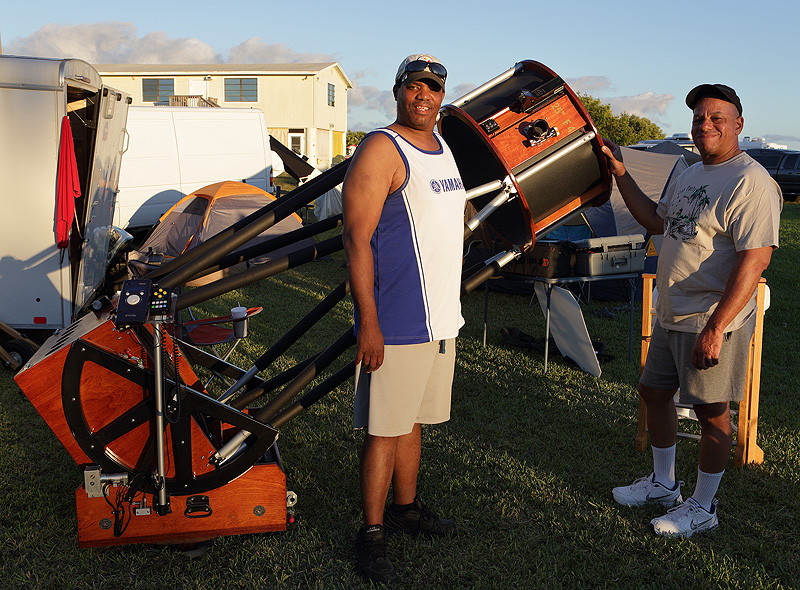 As darkness fell, I kept the photography rolling. Skies were faily clear for most of the night, though scattered clouds passed through from time to time, as is normal. Just sit back, relax, and listen to the wind in the palm trees until the sky clears out again. Tasty beverages are optional. 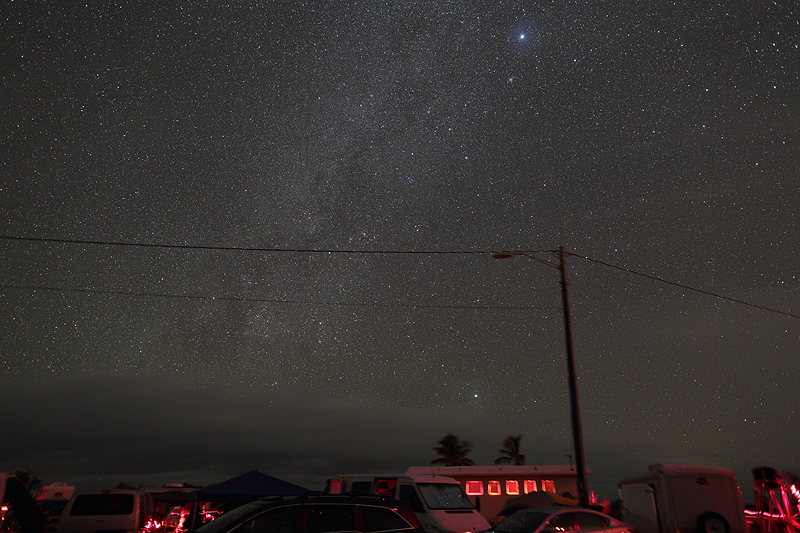 Above, clouds obscrure the far southern horizon as the winter Milky Way rises up toward Sirius. 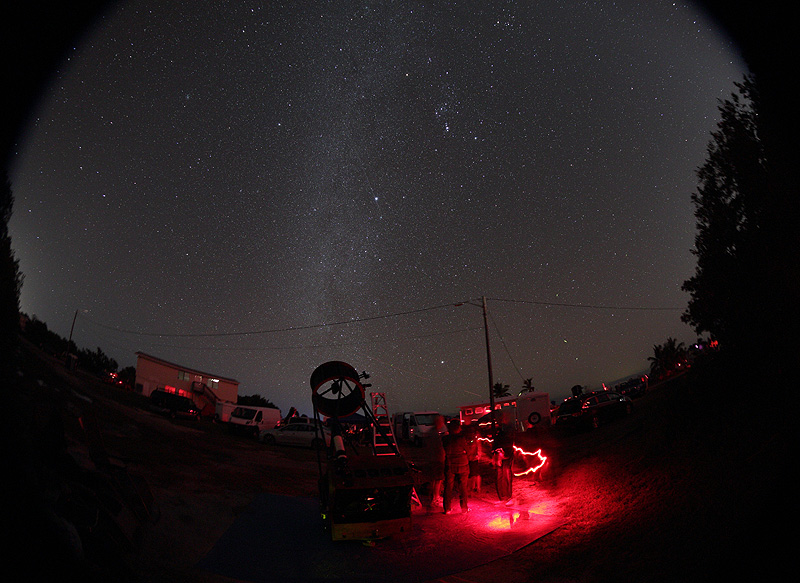 Above, John Pratte's 32" f/3.6 sits beneath the winter sky as observers gather around. This is a very wide-angle lens, and Orion is higher in the sky than it appears in this image. Canopus is the bright star just over the heads of the observers to the right of the telescope eyepiece. 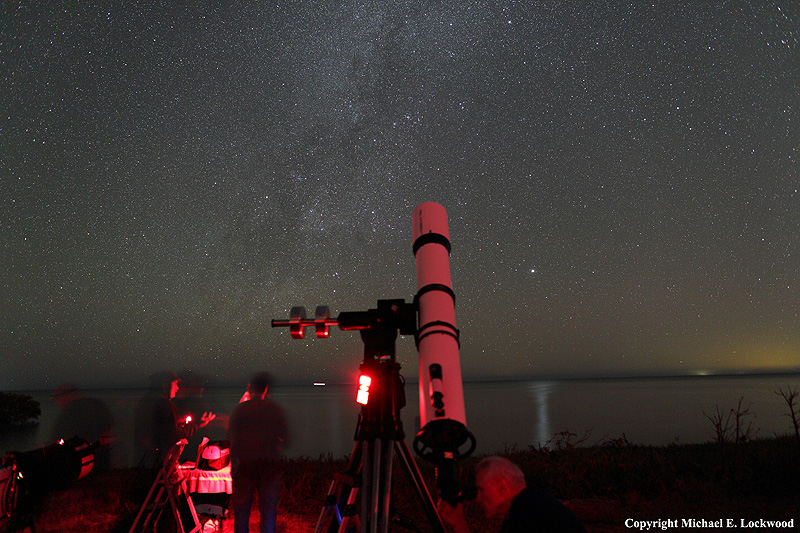 Above Yuri from TEC enjoyes a view of M46 in his huge 10" refractor. Light from Canopus reflects off the fairly calm ocean. Finally, below, the view to the north from the house in Marathon as I pack things up and get ready for an early morning departure. 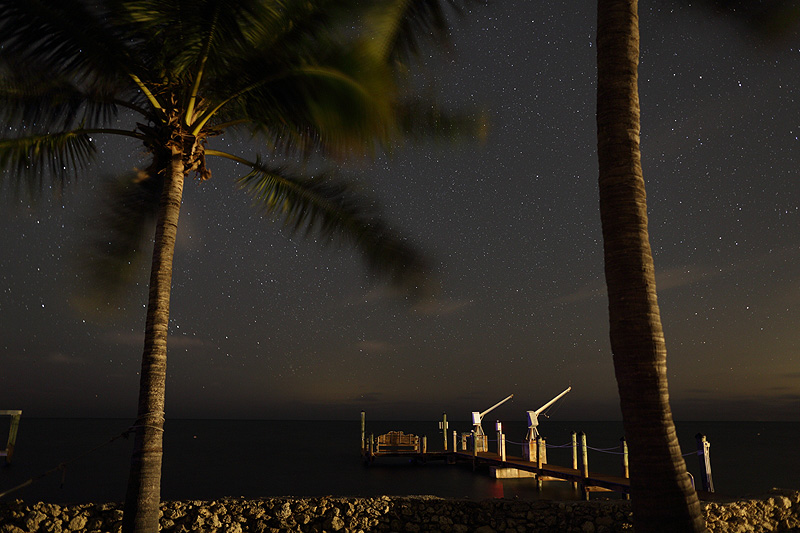 I didn't stay up too late Friday night because I wanted to get an early start the next day to avoid traffic and warmth on the drive back up the coast. Waking up before sunrise, I got a nice early start, was out of Marathon by 7am, and back at my uncle's before noon. We watched the Daytona 500 the next day, and the following weekend I stopped in again and we attended the Grant Seafood Festival a bit on both days. I was able to spend another week and a half in Florida after WSP, and I returned north to Illinois on a beautiful, sunny day. However, when I got home to Illinois at about 9pm at night, I was still wearing shorts in the ~35 degree, very windy weather, and that was a rather rude awakening that I could have done without. Unfortunately changes in lattitude require changes in clothing! |
As I finish writing this article, I am actually catching up on my schedule that has been backlogged for years now. That in itself is as refreshing and rewarding as a week in the Keys, maybe more so. I want to apologize to some clients who had to wait a very long time for projects to be finished, and I hope that I can stay a bit more caught up in the future, but I won't do that at the expense of a much needed vacation in Florida. Warm weather is essential for this optician in the dead of winter. Clear, dark skies, warm weather, good seafood, good friends, good seeing, and cheers. See you at WSP 2018. -Mike Lockwood, Lockwood Custom Optics |